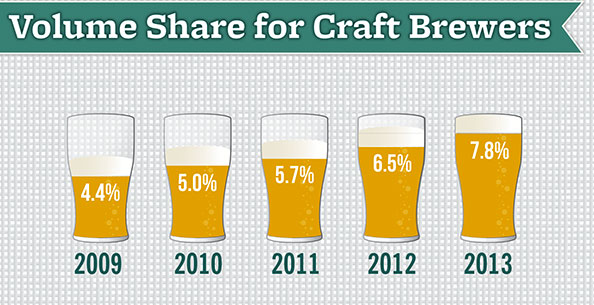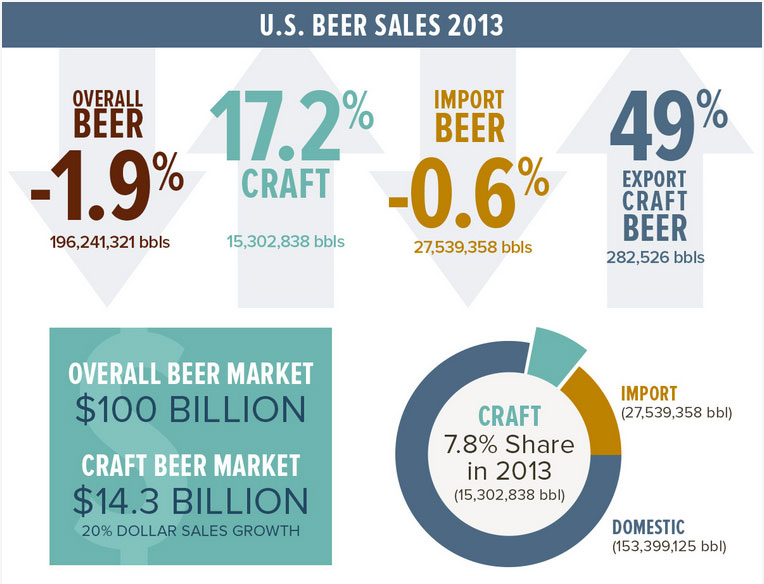Crafty brewing: Is big brand craft-style beer actually a gateway beer?
August 8, 2014

Source: Brewers Association (USA)
TL;DR
Craft beer sales are growing steadily, and the big brewers are responding in a number of ways, including getting in the game with new product lines (think Keith’s Hop Series). Will this strategy help them keep market share (probably, I mean these companies are huge and smart), or be a gateway beer, leading customers closer to their micro-brewing competitors (plausible and a fun to think about unintended consequence)?
State of the industry
This may come as a bit of a surprise, but beer sales per capita are down ever so slightly in the US and Canada [1],[2]. In fact, in Canada it’s been declining since 1975 [1].
But craft beer is up, while imports, which have historically been on the rise, are levelling out. So, it’s the domestic mass-produced beer that’s taking a hit (technically in Canada imports are also up, but this includes beer imported from the US, which I would consider domestic from a marketing perspective for the purpose of this article).

Source: Brewers Association (USA)
Not surprisingly, the mass breweries are responding by creating more brands and varieties in a couple different ways:
-
Making beer that more closely resembles craft beer and shifting their messaging to talk more about beer itself, such as ingredients and process, vs. lifestyle ads like humor or sex (e.g. Keith’s Hop Series, Coors Banquet, Budweiser Crown).
-
Buying craft or import beer brands (InBev bought Corona maker Grupo Modelo and Canadian craft brewery Creemore Springs).
-
Making flavoured and/or lighter beers to appeal to traditionally non-beer drinkers, especially women [3], who account for only 20% of beer sales (the whole Bud Lime and Margarita line, Coors Light Summer Brew, various Shandies – I actually like a Rickard’s Shandy now and then, truth be told). Though not particularly craft-like beer, I think it’s worth noting because I find the number of these products popping up kind of staggering.
Sidebar: Us Canadians have always made fun of American beer, but Budweiser is actually the #1 selling beer in Canada, and California alone has 381 craft breweries, more than Canada (of course they have more people than Canada too, but still).
This is all interesting to me, and what got me started was Alexander Keith’s Hop Series beer, released last summer. I tried it, and it wasn’t too bad. Now, I’m biased, as a fan of a good hoppy, bitter IPA, 6.5%+ or GTFO. To me, the Hop Series tasted like a hops-flavoured pale ale, somewhere between an original Keith’s and a craft IPA. And so I wondered: would this stop some consumers from moving their dollars to craft beer, or would it be a gateway beer to the craft market? I think the latter is possible, and surely more fun to think about. Once you’ve got a taste for something with a little more flavour, and you start to think about what goes into beer which the big brands like Keith’s new advertising pushes (pretty decent ads by the way), then well, what do other beers have to offer? What’s all this about hops?
But I could be wrong. Anecdotally I’ve heard the newest addition to the Hop Series – the Galaxy Hop – is the best selling of the three yet. And it’s the least hoppy to me, in fact it’s strangely sweet. Nevertheless, it’s fun to think about the side effects of this strategy.
This post written under the influence of a Mad Tom IPA from Muskoka Brewery, acquired on my latest trip to Ontario. I highly recommend.
Sources
1. Brewers Association, National Beer Sales & Production Data
2. Beer Canada, Industry Statistics (Per Capita Beer Consumption in Canada)
3. BMO Capital Markets, Good Time for a Beer?